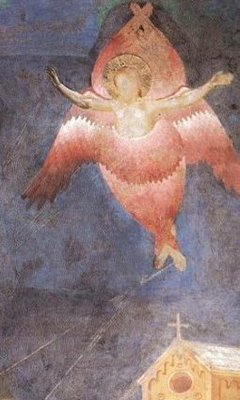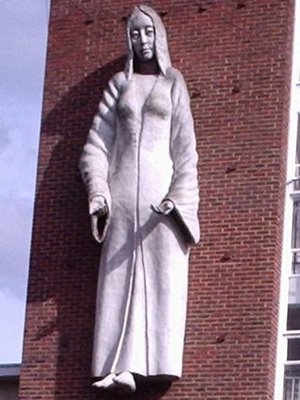The Divided Self: Part III

To accomplish this I leave the Jews and head over to Greece, where the myths are full of triune goddesses. Diana's aspect Hecate, goddess of crossroads and boundaries, had three faces—and see Gawain's post on the three ages of woman here. Three goddesses competed for Paris' apple. There were three Gorgons, three Graeae, three Horae, three Graces, three Furies, and most importantly, three Fates (Latin Parcae, Greek Μοιραι). Something about the Greek woman just seemed to say, Three. Freud, our kabbalistic diviner, discusses these patterns in his well-known essay, 'The Theme of the Three Caskets' (1913). He sees the Moirai (Clotho, Lachesis and Atropos) as the division of a single original goddess into three, by analogy with the Graces and Horae. That original was Atropos, the shearer, literally 'she from whom there is no turning', an emblem of inevitable death:
The earliest Greek mythology only knows one Moira, personifying the inevitable doom (in Homer). The further development of this one Moira into a group of three sisters—goddesses—less often two, probably came about in connection with other divine figures to which the Moirae are clearly related. . .The self-division of Atropos into three was thus not intrinsic to her rôle, and as Freud notes, she was occasionally made into two instead. Plutarch, incidentally, in his essay 'On the E at Delphi', regards as a profound enigma the existence at that temple of two statues to the Fates, rather than the usual three: 'το δύο Μοίρας ιδύσθαι πανταχού τριών νομιζομένων' (385D). In this, the last leg of our journey, we shall see Atropos in her dual aspect, and in her dream-reversal, as the goddess not only of death, but of love.
When Offenbach came to write The Tales of Hoffmann (1881), he adapted Hoffmann's story Der Sandmann (1816) for the first act—the very same story later chosen by Freud to epitomise the uncanny. In this act we find the opera's female lead, Stella, reflected as Olympia, the doll or automaton from Hoffmann's story: a material creation under the dominion of a hidden presence, not an active subject, but a passive object. Freud notes the inherent uncanny in the cultural motif of a 'pretend woman', something familiar made strange, although Olympia is not his primary interest. In Offenbach, Stella and Olympia are doubles. Now, in 1951, the Archers, aka. Powell and Pressburger ("No artist believes in escapism. And we secretly believe that no audience does. We have proved, at any rate, that they will pay to see the truth, for other reasons than her nakedness") decided to shoot a film of The Tales of Hoffmann, and in the leading role, the double Stella / Olympia, they cast their young ballerina-muse, Moira Shearer—or as we must surely now think of her, Atropos.
Shearer had already served the Archers well in The Red Shoes (1948), dancing the lead in that film's famous ballet rendition of Hans Christian Andersen's story of the name. The ballet's plot is amazingly simple: girl acquires red shoes, which are magical; girl dances through a series of increasingly fantastic landscapes; girl can't get shoes off; girl dies in the throes of a Romantic passion. The red shoes—themselves a sort of self divided—exert their sinister force on the dancer, turning her from an active subject into a passive object, a doll. There's a beautiful shot (below) where she first sees the shoes in a shop window, and becomes herself divided across the glass, a doppelgänger. In this scene the personification of love is first directed on the path towards inevitable death. It is most uncanny.

Surprisingly uncanny, also, is the original fairy tale, which is online here. I don't want to summarise the whole plot here, as it is somewhat more complicated than the ballet. The image above is paralleled by two scenes in the original story: the first, where the heroine Karen's looking-glass tells her pointedly 'Thou art more than nice, thou art beautiful!', and the second, where Karen sees her literary double, the princess:
And this little daughter was a princess, and people streamed to the castle, and Karen was there also, and the little princess stood in her fine white dress, in a window, and let herself be stared at; she had neither a train nor a golden crown, but splendid red morocco shoes.In the film, the ballet's Mephistophelean director, played to perfection by Anton Walbrook, claims that at the end of Andersen's story the heroine is killed by the dancing shoes, as she is in the ballet; but this is not true. In the end, in fact, she is redeemed from the shoes' evil, and dies of joy at being allowed into communion. The whole narrative is quite morbid, choked from the start with the threat of death—I adduce these passages:
On the very day her mother was buried, Karen received the red shoes, and wore them for the first time. They were certainly not intended for mourning, but she had no others, and with stockingless feet she followed the poor straw coffin in them.Freud argued that the death-figure of Atropos had been transformed in many contexts into a personification of love: Cordelia, Cinderella, Aphrodite in the Judgement of Paris. This represents unconsious wish-fulfilment, the insurance of the self against death. But here the two figures are blurred: the red shoes as the red lips of sexual passion are pointed up as the road to perdition, although ambiguously, as it is the executioner who strikes off Karen's feet—an image so pregnant with significance—and restores her to spiritual health.
She danced over the churchyard, but the dead did not dance—they had something better to do than to dance.
The shoes carried her over stack and stone; she was torn till she bled; she danced over the heath till she came to a little house. Here, she knew, dwelt the executioner; and she tapped with her fingers at the window, and said, "Come out! Come out! I cannot come in, for I am forced to dance!"
The lady of death and the lady of love are one, so the shaman tells us, opposites conflated in the dreamer's mind. Moira Shearer, the dead doll and the dancerly beauty bound for Romantic oblivion, is a self divided over and over again, according to the fantasy of the male mind—a mind which thirsts for love, and for oblivion, as if those two were one and the same.

























